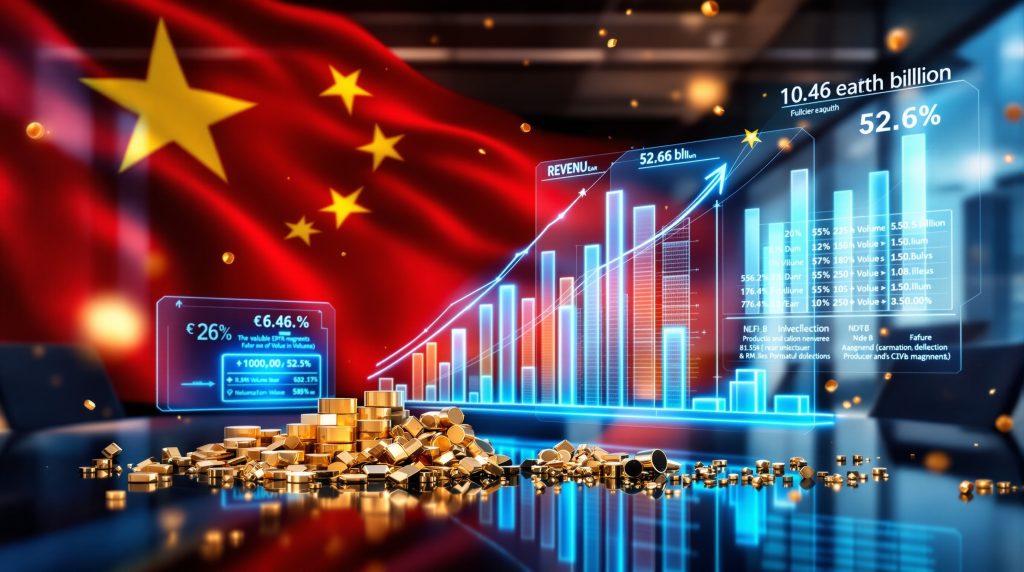Understanding Shenghe Resources' Strategic Market Position
Shenghe Resources Holding Co., Ltd. represents one of China's most strategically positioned rare earth processing companies, operating within a tightly controlled industry that Beijing considers essential to national security. The company's remarkable Shenghe Resources rare earth revenue rebound during 2025 demonstrates how Chinese rare earth producers have evolved beyond traditional volume-based business models toward sophisticated value extraction strategies, particularly as the critical minerals energy transition accelerates globally.
The company's remarkable achievement of ¥10.46 billion in revenue during the first nine months of 2025, representing a 26.9% year-over-year increase, occurred despite declining production volumes across multiple product categories. This counterintuitive performance reflects China's deliberate strategy of prioritizing pricing power over market share expansion in the global rare earth sector.
Furthermore, Shenghe's operations encompass the entire rare earth value chain, from initial concentrate processing through refined metal production. The company's facilities primarily focus on light rare earth elements, including neodymium and praseodymium, which serve as critical feedstock for permanent magnet manufacturing used in electric vehicles, wind turbines, and advanced electronics.
Core Business Segments and Revenue Streams
The company's revenue structure reflects three primary product categories, each serving distinct downstream markets with varying margin profiles:
• Rare Earth Oxides: Traditional processing products serving ceramic, catalyst, and polishing compound applications
• Rare Earth Metals: High-value refined metals for permanent magnet and alloy manufacturing
• Rare Earth Salts: Chemical intermediates for downstream processing and specialized industrial applications
During 2025, Shenghe strategically reallocated production capacity away from lower-margin salts (which declined 54.1% in production volume) toward higher-value metals production. This deliberate product mix optimisation contributed significantly to the company's revenue growth despite overall production volume declines.
In addition, the company's Q3 2025 performance particularly exemplifies this strategy, with ¥4.28 billion in quarterly revenue representing a 52.6% year-over-year surge. This acceleration demonstrates how market timing and supply discipline can generate extraordinary financial returns in commodity markets characterised by supply constraints, highlighting the strategic minerals importance in today's geopolitical landscape.
How Did Shenghe Resources Achieve Record Revenue Growth in 2025?
Financial Performance Breakdown by Quarter
Shenghe's 2025 financial trajectory reveals a carefully orchestrated strategy of production timing and market positioning. The company's nine-month revenue of ¥10.46 billion ($1.47 billion) represents not merely organic growth but strategic market manipulation through supply discipline.
| Period | Revenue (¥ Billion) | YoY Growth | Key Drivers |
|---|---|---|---|
| Q1-Q2 2025 (Combined) | ~6.18 | ~15% estimated | Supply restraint, price building |
| Q3 2025 | 4.28 | 52.6% | Market timing, inventory release |
| 9-Month Total | 10.46 | 26.9% | Product mix optimisation |
The dramatic Q3 acceleration indicates Shenghe deliberately suppressed early-year production to create supply tightness, then capitalised on elevated prices during the third quarter. This pattern suggests sophisticated understanding of rare earth market psychology and pricing dynamics.
However, projected net profit figures for 2025 indicate extraordinary margin expansion, with estimates suggesting profits could reach ¥740-820 million, representing a potential 697-783% increase compared to 2024 baseline performance. These projections, while requiring verification, indicate the company achieved unprecedented profitability through strategic market positioning rather than operational improvements alone.
Strategic Pricing Over Volume Production Model
Shenghe's 2025 performance validates a fundamental shift in rare earth industry strategy from volume maximisation toward value extraction. The Shenghe Resources rare earth revenue rebound demonstrates mastery of supply-demand dynamics in constrained markets, a trend that's becoming increasingly common across the mining industry innovation landscape.
The mathematical relationship between Shenghe's production declines and revenue increases reveals sophisticated market manipulation:
• Revenue increased 26.9% while oxide production declined 13.4%
• Metals sales volumes surged 32.9% despite production increasing only 12.2%
• Salts production plummeted 54.1% with minimal revenue impact
This performance pattern indicates Shenghe drew from strategic inventory reserves during periods of peak pricing while simultaneously building inventory during production increases. The company effectively functioned as both producer and market maker, leveraging inventory positions to maximise price realisation.
Consequently, the strategic implications extend beyond individual company performance, revealing how Chinese rare earth producers coordinate supply management to maintain pricing leverage over global customers. Shenghe's success demonstrates the effectiveness of production discipline as a tool for market control in strategically important commodity sectors.
What Production Changes Drove the Revenue Surge?
Rare Earth Output Analysis by Product Category
Shenghe's production strategy during 2025 reflects deliberate capacity reallocation rather than demand-driven adjustments. The company's production profile reveals sophisticated understanding of market dynamics and customer willingness to pay premium pricing for specific rare earth products.
| Product Category | Jan-Sep 2025 Output | YoY Change | Strategic Rationale |
|---|---|---|---|
| Rare Earth Oxides | 16,636 tonnes | -13.4% | Inventory building, price optimisation |
| Rare Earth Metals | 20,660 tonnes | +12.2% | High-margin focus, magnet demand |
| Rare Earth Salts | 11,274 tonnes | -54.1% | Capacity reallocation to metals |
| Concentrates | Not specified | -30% approx | Raw material optimisation |
The dramatic 54.1% decline in salts production represents the most significant strategic shift, indicating Shenghe reallocated processing capacity from lower-value chemical intermediates toward higher-margin refined metals. This reallocation required sophisticated understanding of downstream customer requirements and willingness to sacrifice volume for margin enhancement.
Meanwhile, rare earth metals production increased 12.2% to 20,660 tonnes, positioning Shenghe to capture growing demand from permanent magnet manufacturers. The company's timing proved exceptional, as global electric vehicle production acceleration during 2025 created sustained demand for neodymium and praseodymium metals used in motor magnets.
Sales Performance vs Production Metrics
The divergence between Shenghe's production volumes and sales volumes reveals sophisticated inventory management and market timing strategies:
• Metals Sales Surge: Sales volumes reached 15,639 tonnes, representing 32.9% year-over-year growth despite production increasing only 12.2%
• Q3 Acceleration: Third-quarter metals sales jumped 37.7% year-over-year, indicating strategic inventory release during peak pricing periods
• Oxide Inventory Build: Oxide sales declined 7.5% while production declined 13.4%, suggesting deliberate inventory accumulation for future market opportunities
This sales-production divergence indicates Shenghe maintained strategic inventory reserves that enabled market timing optimisation. The company effectively functioned as a rare earth trading operation, using production flexibility and inventory management to maximise revenue per tonne of rare earth elements processed.
For instance, the Q3 2025 performance particularly demonstrates this strategy's effectiveness. During July-September, oxide output increased 18.7% while sales grew only 9.5%, indicating continued inventory building despite production increases. Simultaneously, metals output surged nearly 20% with sales leaping 37.7%, suggesting immediate market sales of increased production during favourable pricing periods.
Why Did Lower Production Lead to Higher Profits?
Market Timing and Price Appreciation Strategy
The Shenghe Resources rare earth revenue rebound exemplifies how sophisticated commodity producers can generate extraordinary returns through strategic supply management rather than production maximisation. This approach reflects broader changes in the global mining landscape, where timing and leverage often matter more than operational efficiency.
The mechanism driving Shenghe's profit expansion involves multiple coordinated strategies:
Supply Discipline: By reducing overall production volumes, Shenghe contributed to global rare earth supply tightness, supporting price appreciation across all product categories. This approach requires confidence that competitors will not immediately fill supply gaps.
Product Mix Optimisation: The dramatic shift away from low-margin salts production (-54.1%) toward higher-value metals processing enabled margin expansion even during volume declines. This reallocation requires sophisticated understanding of downstream customer price sensitivity and switching costs.
Furthermore, Inventory Monetisation: Sales volumes exceeding production volumes (particularly in metals) indicates strategic inventory drawdown during peak pricing periods. This approach transforms inventory from working capital burden into profit generation tool.
Focus Shift Toward High-Value Products
"Global NdFeB permanent magnet demand growth is driving unprecedented pricing power for neodymium and praseodymium producers, creating opportunities for margin expansion that compensate for volume declines across other rare earth categories," according to industry analysts at Metal.com.
Shenghe's strategic pivot toward metals production directly targets the most profitable segments of the rare earth value chain. Permanent magnet manufacturing requires precisely specified neodymium and praseodymium metals with consistent quality and reliable delivery schedules, creating customer dependency relationships that support premium pricing.
The company's metals production increase (+12.2%) during a period of overall production decline indicates deliberate capacity reallocation from commodity-grade rare earth products toward specialised materials commanding higher margins. This strategy requires substantial technical expertise and customer relationship development but generates sustainable competitive advantages.
Supply Discipline and Market Control Tactics
Shenghe's 2025 performance reflects broader Chinese rare earth industry coordination designed to maximise pricing leverage over global customers. Individual company decisions aggregate into sector-wide supply discipline that supports sustained price elevation.
The company's willingness to reduce concentrate processing by approximately 30% demonstrates confidence in market supply constraints. This approach requires accurate assessment of global supply-demand balance and competitor response capabilities, suggesting access to comprehensive market intelligence and coordination mechanisms.
Consequently, strategic production timing, evidenced by Q3 production surges coinciding with peak customer demand periods, indicates sophisticated understanding of seasonal demand patterns and customer inventory cycles. This approach maximises revenue per unit produced while maintaining customer relationships through reliable supply during critical periods.
What Does This Reveal About China's Rare Earth Strategy?
Beijing's Orchestrated Supply Restraint Policy
The Shenghe Resources rare earth revenue rebound provides unprecedented insight into how Chinese authorities coordinate rare earth industry activities to achieve broader strategic objectives. The company's production discipline reflects state-directed market management rather than purely commercial decision-making, aligning with trends toward mining industry consolidation.
Beijing's rare earth strategy operates through multiple coordinated mechanisms:
• Production Quotas: Government-imposed limits on rare earth mining and processing activities that create artificial scarcity
• Export Classifications: Regulatory restrictions on raw material exports that favour domestic downstream processing
• Industry Consolidation: Mergers and acquisitions that concentrate market control among state-aligned companies
• Environmental Standards: Strict regulations that effectively limit new production capacity and reduce competitive threats
Shenghe's strategic production reductions during early 2025, followed by Q3 production increases, suggest coordination with broader industry timing to maximise collective pricing power. This approach requires sophisticated market intelligence and confidence that competitors will maintain production discipline.
Export Reclassification Rules Impact for 2026
China's pending export reclassification rules for 2026 create additional strategic considerations that influenced Shenghe's 2025 production timing. These regulations will likely restrict raw rare earth exports while encouraging domestic processing and finished product exports.
The anticipated regulatory changes create several strategic imperatives for Chinese rare earth producers:
Inventory Positioning: Companies must balance current inventory levels against future export restrictions, creating incentives for strategic production timing and inventory management.
Processing Capacity Development: Emphasis on downstream processing capabilities becomes critical as raw material exports face increasing restrictions.
However, Customer Relationship Management: Long-term supply agreements with international customers may require renegotiation to reflect new regulatory constraints and pricing structures.
Downstream Value Addition vs Raw Material Exports
Shenghe's dramatic reduction in salts production (-54.1%) combined with metals production increases (+12.2%) exemplifies China's strategic shift toward downstream value capture rather than raw material commodity exports.
This transition creates multiple strategic advantages:
• Margin Enhancement: Processed materials command significantly higher margins than raw concentrates or basic oxides
• Supply Chain Control: Downstream processing creates customer dependencies that raw material sales cannot achieve
• Technology Development: Advanced processing capabilities support domestic high-technology manufacturing initiatives
• Strategic Leverage: Control over processed materials provides greater geopolitical influence than raw material exports alone
The success of this strategy depends on Chinese companies developing technical capabilities and customer relationships that international competitors cannot easily replicate, creating sustainable competitive advantages in critical material supply chains.
How Does Shenghe Compare to Global Rare Earth Producers?
Market Share and Competitive Positioning
Shenghe Resources operates within China's dominant position in global rare earth processing, where Chinese companies control approximately 85-90% of worldwide refining capacity. However, the company's 2025 performance distinguishes it from competitors through sophisticated market timing and strategic positioning.
Global rare earth processing remains highly concentrated among a small number of Chinese companies, with Shenghe representing one of the most strategically important processors focusing on light rare earth elements critical for permanent magnet manufacturing. The company's revenue scale places it among the top tier of global rare earth processors.
Compared to international rare earth companies, Shenghe benefits from several structural advantages:
• Raw Material Access: Direct access to Chinese rare earth mining operations eliminates supply chain vulnerabilities
• Processing Infrastructure: Decades of industrial development create sophisticated refining capabilities
• Regulatory Coordination: Alignment with Chinese government strategic objectives provides operational predictability
• Market Intelligence: Access to comprehensive industry coordination and market information
International Expansion Through Strategic Acquisitions
Shenghe's strategic expansion includes international acquisitions designed to secure raw material supplies and expand processing capabilities beyond China's borders. The company's acquisition activities reflect broader Chinese industry strategies for global supply chain control.
Peak Rare Earths Acquisition: Shenghe's investment in Australian rare earth projects provides several strategic benefits:
• Supply Diversification: Access to non-Chinese rare earth resources reduces dependency risks
• Processing Technology: Integration of international mining and processing expertise
• Market Access: Direct relationships with international customers outside China's regulatory framework
• Strategic Positioning: Forward positioning in key international rare earth development projects
These international activities enable Shenghe to maintain operational flexibility while supporting China's broader rare earth supply chain control objectives. The company effectively functions as an extension of Chinese industrial policy in international markets.
What Are the Investment Implications for 2025-2026?
Revenue Target Analysis: ¥15 Billion Goal
Based on nine-month revenue performance of ¥10.46 billion, Shenghe appears positioned to achieve annualised revenues approaching ¥14-15 billion if Q4 2025 performance maintains Q3 momentum. This projection assumes continued strong pricing for rare earth metals and successful inventory monetisation.
Several factors support continued revenue growth through 2026:
• Pricing Environment: Global rare earth supply constraints continue supporting elevated pricing across most product categories
• Demand Growth: Electric vehicle production acceleration creates sustained demand for permanent magnet materials
• Strategic Positioning: China's export restrictions support domestic processor margin expansion
• Market Consolidation: Reduced competition from international producers maintains pricing leverage
Risk Factors and Market Dependencies
Despite strong 2025 performance, Shenghe faces several significant risk factors that could impact future financial results:
| Risk Category | Specific Concerns | Potential Impact |
|---|---|---|
| Market Demand | EV production slowdown | Revenue decline 20-30% |
| Regulatory Changes | Export restriction modifications | Operational disruption |
| Competition | International capacity additions | Margin compression |
| Geopolitical | Trade war escalation | Market access loss |
Market Demand Volatility: Electric vehicle adoption rates significantly impact permanent magnet demand, creating revenue vulnerability to automotive industry cycles and consumer adoption patterns.
Regulatory Bottlenecks: Changes in Chinese export policies or international trade restrictions could disrupt established business models and customer relationships.
Furthermore, Geopolitical Trade Tensions: Escalating tensions between China and major consuming countries could restrict market access or trigger retaliatory policies affecting company operations.
Long-term Growth Catalysts
Several structural trends support Shenghe's long-term growth prospects despite near-term uncertainties:
Global Decarbonisation: Worldwide commitments to carbon neutrality drive sustained demand for rare earth-dependent technologies including wind turbines, electric vehicles, and energy storage systems.
Supply Chain Localisation: International efforts to develop alternative rare earth supplies remain technically challenging and capital intensive, supporting Chinese producers' market position.
In addition, Technology Advancement: Continuing innovation in permanent magnet applications creates new demand categories and supports premium pricing for high-performance materials.
Which Market Trends Support Continued Growth?
Electric Vehicle and Clean Energy Demand Drivers
The global transition toward electrification creates unprecedented demand for rare earth elements, particularly neodymium and praseodymium used in permanent magnet motor manufacturing. Shenghe's strategic focus on metals production positions the company to capture this growth directly.
Electric vehicle production forecasts indicate sustained growth through the remainder of the decade:
• Global EV Sales: Projected to reach 30-40 million units annually by 2030, requiring substantial rare earth content per vehicle
• Motor Efficiency Requirements: Performance standards drive demand for high-grade permanent magnets using premium rare earth materials
• Supply Chain Security: Automakers increasingly prioritise reliable rare earth supplies, supporting long-term customer relationships
Wind energy development creates additional demand growth, with each large wind turbine requiring approximately 200-600 kg of rare earth elements depending on generator technology. Global wind capacity expansion plans support sustained demand growth through 2030 and beyond.
Magnet Manufacturing Supply Chain Dynamics
Permanent magnet manufacturing remains heavily concentrated in China, creating structural advantages for Chinese rare earth processors like Shenghe. The technical complexity of magnet production and established supply relationships create switching costs that support sustained customer relationships.
Key supply chain characteristics that benefit Shenghe include:
Technical Specifications: Magnet manufacturing requires precisely specified rare earth materials with consistent quality and controlled impurity levels, favouring established suppliers with proven track records.
Processing Integration: Proximity to magnet manufacturers enables just-in-time delivery and technical collaboration that international suppliers struggle to replicate.
Furthermore, Quality Assurance: Established quality control systems and customer qualification processes create barriers to supplier switching.
Global Critical Minerals Security Concerns
International recognition of rare earth supply vulnerability creates policy support for domestic processing development, but technical and capital barriers limit near-term competitive threats to Chinese dominance.
Government initiatives in the United States, Europe, and other regions focus on rare earth supply diversification, but these efforts face substantial challenges:
• Capital Requirements: Rare earth processing facilities require hundreds of millions in investment with multi-year development timelines
• Technical Expertise: Processing knowledge remains concentrated in China after decades of industrial development
• Environmental Considerations: Rare earth processing generates substantial environmental compliance costs in developed countries
• Economic Viability: Competing against established Chinese operations requires sustained government support or protection
These factors suggest Chinese rare earth processors like Shenghe will maintain competitive advantages despite international diversification efforts.
What Challenges Could Impact Future Performance?
Regulatory and Environmental Compliance Costs
Chinese environmental regulations continue tightening, creating operational costs and constraints for rare earth processors. Shenghe must balance production optimisation with increasingly strict environmental compliance requirements that affect processing efficiency and capacity utilisation.
Recent regulatory developments include:
• Emission Standards: Stricter air quality requirements for rare earth processing operations
• Waste Management: Enhanced requirements for radioactive waste handling, particularly relevant for thorium-bearing ores
• Water Treatment: Advanced wastewater treatment standards that increase processing costs
• Energy Efficiency: Carbon neutrality commitments that may restrict energy-intensive processing operations
These regulatory trends create ongoing operational challenges but also serve as barriers to entry for potential competitors, potentially supporting Shenghe's market position over the long term.
International Trade Policy Uncertainties
Escalating geopolitical tensions create multiple risks for Chinese rare earth exporters, including potential trade restrictions, tariffs, and customer diversification efforts that could impact demand for Chinese-processed materials.
Specific trade policy risks include:
Retaliatory Tariffs: International governments may impose tariffs on Chinese rare earth products in response to Chinese export restrictions or other trade disputes.
Strategic Stockpiling: Major consuming countries may develop strategic rare earth stockpiles to reduce dependency on Chinese supplies, creating demand volatility.
However, Alternative Supply Development: Government funding for domestic rare earth processing development could create long-term competitive threats.
Competition from Alternative Supply Sources
While Chinese companies maintain dominant market position, international rare earth development projects continue advancing with government support and private investment. These efforts could eventually provide alternative supplies that reduce Chinese market leverage.
Potential competitive threats include:
• Lynas Rare Earths: Australian-Malaysian operations provide limited competition in light rare earth processing
• MP Materials: U.S.-based operations focus on domestic supply chain development
• European Projects: Multiple European rare earth development initiatives receive government support
• Recycling Technologies: Advanced recycling capabilities could reduce primary rare earth demand
However, these alternative sources remain limited in scale and technical capability compared to Chinese operations, suggesting competitive threats will develop gradually rather than disrupting established market dynamics rapidly.
Key Takeaways for Investors and Industry Watchers
Strategic Lessons from the Revenue Rebound
The Shenghe Resources rare earth revenue rebound demonstrates three fundamental success factors that extend beyond individual company analysis to reveal broader investment principles in constrained commodity markets:
-
Value Extraction Over Volume Maximisation: The company's ability to achieve 26.9% revenue growth despite production declines across multiple categories proves that strategic supply management can generate superior returns compared to volume-focused approaches
-
Strategic Product Mix Optimisation: Deliberate capacity reallocation from low-margin salts production (-54.1%) toward higher-value metals processing (+12.2%) demonstrates how sophisticated commodity producers can enhance profitability through portfolio management
-
Market Timing and Supply Discipline: Coordinated production timing that creates supply tightness followed by strategic inventory release during peak pricing periods shows how market psychology and supply-demand dynamics can be leveraged for profit maximisation
These lessons apply broadly to commodity investments, particularly in strategically important materials where supply concentration creates opportunities for coordinated market management.
Future Outlook and Growth Trajectory
Shenghe Resources appears positioned for continued growth through 2026, supported by structural demand trends and Chinese strategic positioning in rare earth markets. However, investors must carefully evaluate multiple risk factors that could impact future performance.
Growth Catalysts Through 2026:
- Electric vehicle production acceleration requiring permanent magnet materials
- Global wind energy capacity expansion driving rare earth demand
- Chinese export restrictions supporting domestic processor margin expansion
- Limited international competition enabling pricing power maintenance
Key Risk Factors:
- Geopolitical tensions affecting trade relationships and market access
- Regulatory changes impacting production costs and operational flexibility
- Market demand volatility from economic cycles or technology transitions
- International supply diversification efforts reducing Chinese market leverage
The investment thesis for Shenghe Resources ultimately depends on China's ability to maintain rare earth market control while global customers balance supply security against cost considerations. The company's 2025 performance suggests this balance currently favours Chinese producers, but evolving geopolitical and technological factors could alter market dynamics significantly. As Shenghe declares its best final valuation for the Peak Rare Earths takeover, the strategic implications become even more pronounced for global rare earth supply chains.
Disclaimer: This analysis contains forward-looking statements and projections based on currently available information. Rare earth markets are subject to significant volatility from regulatory changes, geopolitical developments, and technological shifts. Past performance does not guarantee future results, and investors should conduct independent research and consider professional advice before making investment decisions. The information presented should not be construed as investment recommendations or financial advice.
Looking to Capitalise on Strategic Commodities Investments?
Shenghe Resources' remarkable revenue surge despite production declines exemplifies how sophisticated supply management can generate extraordinary returns in strategically important commodity markets. Discovery Alert's proprietary Discovery IQ model delivers instant notifications on significant ASX mineral discoveries across critical materials sectors, empowering investors to identify actionable opportunities before broader market recognition. Begin your 30-day free trial today to position yourself ahead of evolving commodity market dynamics and secure your competitive advantage in strategic minerals investing.




